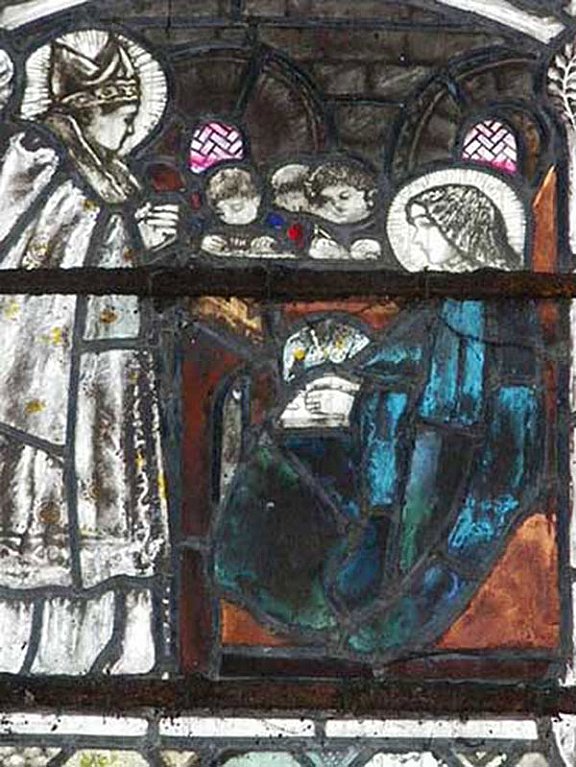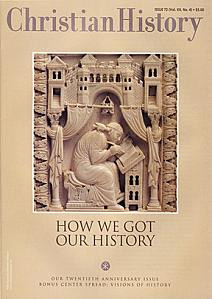Soon to Be a Famous Abbess, Hild Was Baptized

St Aidan visits St Hilda- Gloucester Cathedral, courtesy Wikipedia /Weglinde.
CHRIST’S RESURRECTION, celebrated at Easter, is such a pivotal Christian doctrine that quite early in church history Easter became a favorite day for baptisms. When Paulinus converted King Edwin of Northumbria (northern England) to Christianity, the king and many of his courtiers were baptized at Easter in a timber structure that was hastily erected at York. Among those who accepted the rite on this day, 12 April 627 was a thirteen-year-old girl named Hild. Closely related to the king, she would have a remarkable influence on her country.
Twenty years after her baptism, Hild became a nun. The thirty-three-year-old woman planned to join a sister in a convent at Chelles, France, and traveled to East Anglia to await a favorable moment for crossing the English Channel.
There Aiden, a monk, evangelist, and bishop in Northumbria, urged her to return to her own people instead and set up a monastery in England. He put her in charge of a small monastic community at Hartlepool that included both men and women. She proved to be such a capable administrator that King Oswiu awarded her with the land on which she built the more important double monastery at Streoneshalh. (A double monastery is one with both men and women.) Two hundred years later, the Danes renamed the town Whitby, and so history knows her as Hild of Whitby.
Hild focused the attention of her religious community on Bible reading and good works. This regimen was so successful that five of the men under her tutelage became bishops of the Anglo-Saxon church. Church historian Bede, writing in the following century, remarked that all of them were “men of singular merit and sanctity, whose names were Bosa, Hedda, Oftfor, John, and Wilfrid.”
In addition to training bishops, Hild discovered the poet Caedmon and encouraged him to sing his religious poems which retold the Bible stories in old English, the language that the common people understood. Although little of his work survives, he is hailed as the first poet to write in vernacular English.
In the seventh century, the English church was divided between those who wanted to follow Celtic Christian practices and those who wanted to adhere to Roman forms. King Oswiu determined to hold a church council to settle once for all which practice his people would follow. He asked Hild to host the event. And so the most important council in English history met at her monastery in Streoneshalh in 664—the Synod of Whitby.
Arguing for the Roman side was Wilfred who had trained in England, Gaul, and Rome. Hild herself preferred the Celtic forms. Alongside Bishop Colman, she argued for them at the synod. However, the king decided to adopt Roman practices. Unlike some church leaders who clung stubbornly to the Celtic tradition, Hild acquiesced in the new arrangement. She was ill the last seven years of her life, dying near dawn one morning in 680.
—Dan Graves
----- ----- -----
For background on Hild's Christianity, see "Oswald and Aidan" (an excerpt from Bede) in Christian History #72 How We Got Our History






